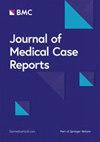意外发现结肠内脾脏异位,模仿上皮下肿瘤:病例报告
IF 0.9
Q3 MEDICINE, GENERAL & INTERNAL
引用次数: 0
摘要
本病例报告旨在描述一例史无前例的病例,该病例通过内窥镜超声引导活检获得的材料,经组织学和免疫组化诊断为结肠脾异位。脾异位是一种良性疾病,其特点是脾组织种植在远离其通常解剖部位的区域,如腹膜、网膜、肠系膜、肝脏、胰腺和皮下组织,更罕见的是种植在结肠和大脑等部位。它一般与脾外伤或脾切除术史有关,通常不会引起特殊症状。一名 35 岁的白人男性患者身体健康,无外伤或脾切除史,但有结肠直肠肿瘤家族史,接受了结肠镜筛查。检查发现,降结肠近端有一个巨大的隆起,被正常外观的粘膜覆盖。在内镜超声引导下,用 22 号细针穿刺活检,组织病理学和免疫组化分析结果与异位脾脏一致。这是首次报道利用内镜超声和超声引导活检获得的材料,通过组织学和免疫组化诊断结肠内脾脏异位的原发性结肠内脾肿大病例。本文章由计算机程序翻译,如有差异,请以英文原文为准。
Incidental finding of intramural splenic heterotopy in the colon mimicking subepithelial neoplasm: a case report
The aim of this case report is describe an unprecedented case with histological and immunohistochemical diagnosis of splenic heterotopy in the colon using material obtained by endoscopic ultrasound-guided biopsy. Splenic heterotopia is a benign condition characterized by the implantation of splenic tissue in areas distant from its usual anatomical site, such as the peritoneum, omentum, mesentery, liver, pancreas, and subcutaneous tissue and, more rarely, in locations such as the colon and brain. It is generally associated with a history of splenic trauma or splenectomy and typically does not cause specific symptoms. A 35-year-old white male patient who was healthy, with no history of trauma or splenectomy, but had a family history of colorectal neoplasia underwent colonoscopy for screening. The examination revealed a large bulge in the proximal descending colon, covered by normal-appearing mucosa. Endoscopic ultrasound-guided puncture was performed with a 22 gauge fine needle biopsy, and the histopathological and immunohistochemical analysis results were consistent with a heterotopic spleen. This is the first report of a primary intramural colic splenosis case with histological and immunohistochemical diagnosis of splenic heterotopia in the colon, using material obtained by endoscopic ultrasound and ultrasound-guided biopsy.
求助全文
通过发布文献求助,成功后即可免费获取论文全文。
去求助
来源期刊

Journal of Medical Case Reports
Medicine-Medicine (all)
CiteScore
1.50
自引率
0.00%
发文量
436
期刊介绍:
JMCR is an open access, peer-reviewed online journal that will consider any original case report that expands the field of general medical knowledge. Reports should show one of the following: 1. Unreported or unusual side effects or adverse interactions involving medications 2. Unexpected or unusual presentations of a disease 3. New associations or variations in disease processes 4. Presentations, diagnoses and/or management of new and emerging diseases 5. An unexpected association between diseases or symptoms 6. An unexpected event in the course of observing or treating a patient 7. Findings that shed new light on the possible pathogenesis of a disease or an adverse effect
 求助内容:
求助内容: 应助结果提醒方式:
应助结果提醒方式:


